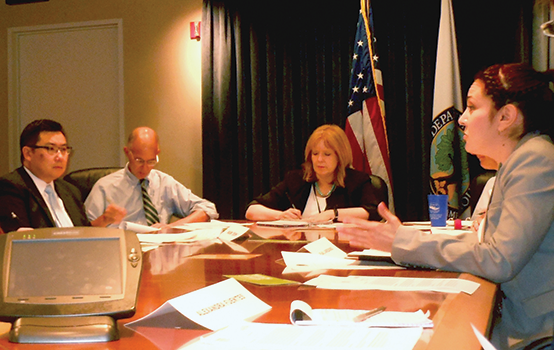
Effective teacher leadership improves teaching and learning outcomes and gives teachers voice in policy making at all levels.
Throw around the phrase “teacher leadership” in a room of education professionals, and you’ll likely get a lot of enthusiastic nodding. It’s hard to argue with the idea of teachers taking on leadership roles to improve their profession. For more than a generation, education leaders have advocated for policies at federal, state, and district levels to support the spread of teacher leadership. And yet, teacher leadership has not taken hold in either a strategic or systemic way.
Why? Perhaps, as Atul Gawande said of the medical industry, while good ideas abound, not all of them spread (2013). Ideas that do spread share two important qualities: They solve a clearly defined problem, and they benefit the general public as well as practitioners. The failure of teacher leadership to take hold has been a failure to define its purpose beyond the generic, albeit laudable, ideal of increased professionalism for teachers.
Policy making is fundamentally about resource allocation. Policies favor interventions that can answer the key questions: Who benefits, how, and to what degree? Those of us who work in the teacher leadership space must ask: How do we make teacher leadership indispensable? How do we ensure that policy makers believe it is a priority and not the first item that gets slashed when budgets are tight?
The obvious way to achieve this is to prove that teacher leadership fosters school improvement, principally evidenced by growth in student learning. However, almost 30 years after the Holmes Group and Carnegie Task Force on Teaching as a Profession brought national attention to the issue, the link between teacher leadership and increased student achievement has remained tenuous at best.
For teacher leadership to have staying power, it must prove itself to be genuinely influential — to matter more than other strategies for improving schools.
Today, reforms in teacher evaluation nationwide make it increasingly feasible to target leadership positions at demonstrably effective teachers. This has a twofold impact. First, teacher leaders are more likely to be respected as credible by the peers they seek to influence, and second, the teachers doing the leading are more likely to share practices that have a positive influence on student achievement.
As baby boomers retire and those with less than 10 years experience teaching have become the majority of the teaching force, teacher leadership is experiencing a resurgence in popularity (NCES, 2008). For teacher leadership to have staying power this time, it must prove itself to be genuinely influential — to matter more than other strategies for improving schools. At Teach Plus, we have identified five measurable goals for teacher leadership:
- Improve student outcomes;
- Improve the access of high-need students to effective teachers;
- Extend the careers of teachers looking for growth opportunities;
- Expand the influence of effective teachers on their peers; and
- Ensure a role for teachers as leaders in policy decisions affecting their practice.
Why teacher leadership?
Our work at Teach Plus is rooted in the belief that leadership opportunities for teachers have a measurable, positive effect on students, schools, and the teaching profession. Teach Plus recruits, selects and trains outstanding teachers to be leaders in their schools and in district and state policy debates. We have worked with almost 1,000 teachers in six cities to date. Our programs engage teachers as change makers at the school and system levels while acknowledging that different teachers want different avenues for leadership.
At the school level, the Turnaround Teacher Teams Initiative (T3) recruits and supports cohorts of effective, experienced teachers to be teacher leaders in chronically low-performing schools. The T3 Initiative operates in 12 schools in partnership with Boston Public Schools, Fall River (Mass.) Public Schools, and District of Columbia Public Schools.
At the system level, our Teaching Policy Fellowship offers effective urban teachers a range of platforms to advocate for policies they believe will benefit students. These opportunities include direct engagement with policy makers, congressional testimony, media placements, and public forums for voicing their opinions. Here is the reasoning for and the ways in which we advance toward our teacher leadership goals.
#1. Improve student outcomes across a school.
Teacher leadership has always had implicit ties to supporting improved student learning. Teacher leadership emerged in the mid-1980s in response to the education crisis outlined in A Nation at Risk. Empowering teachers as professional leaders was an answer to the question of how to prepare students to compete in an increasingly competitive and knowledge-driven global economy. Yet a clear link between teacher leadership and student achievement has remained elusive.
In this era of accountability, teacher leadership advocates must insist on examining more explicit links. Our T3 Initiative is beginning to measure the effect of teacher leadership on student learning, and early results are promising.
In the first cohort of six T3 schools in Boston — all labeled “turnaround” schools by the state — student scores went up in every school over a period of two years. On average, scores improved schoolwide by more than 16 points in math and more than 12 points in English language arts (Teach Plus, 2012). By contrast, scores in the remainder of the district were flat or declining, as were scores in other schools statewide that were given the turnaround designation. Recently, state officials removed two-thirds of the initial T3 schools from turnaround status based on the schools’ consistent improved performance.
#2. Improve access of high-need students to effective teachers.
The early results of the T3 Initiative point to another key outcome for teacher leadership: its capacity to attract high-performing teachers to low-performing schools. The recently updated No Child Left Behind waiver requirements indicate an increased emphasis on equalizing student access to effective teachers. A wide body of research indicates that high-need students are disproportionately saddled with low-performing teachers (Education Trust-West, 2012), and conventional wisdom has long held that low-performing schools can’t attract significant numbers of experienced, effective teachers.
The T3 Initiative proves that is not the case. Maria Fenwick was among the group of teachers who developed the T3 Initiative. She wrote:
As we dug into research on the inequitable distribution of effective teachers, a surprising narrative came to light: Many policy makers thought it wasn’t possible to convince experienced, effective teachers to teach in the so-called worst schools.
From our experience, we knew that was incorrect. We believed teachers like us would be eager for the challenge to teach in an underperforming, hard-to-staff school . . . if the right conditions were in place. Over the next several months, we set out to define what those conditions would be (Fenwick, 2013).
Those conditions included a critical mass of solutions-oriented colleagues (T3 teacher leaders compose 20% to 25% of the teaching staffs at each partner school), a clear and defined leadership role, a principal committed to a model of shared school leadership, an intensive network of support, and additional compensation.
With those conditions in place, the T3 Initiative now receives, on average, 7.5 applications for every open teacher leader position. Our highest-performing teachers clearly can be attracted to our most challenging schools, and well-structured, well-supported teacher leadership opportunities are an avenue to achieve that.
#3. Extend careers of teachers looking for growth opportunities.
Attrition is a growing problem in the teaching profession. Last year, The New Teacher Project (TNTP) reported that the nation’s 50 largest urban school districts lose some 10,000 high-performing teachers each year (2012). That problem is exacerbated for low-income students and students of color, who are two to three times more likely than their more affluent peers to be assigned a weaker teacher (Education Trust-West, 2012).
To leverage teacher leadership to address the challenge of teacher attrition, leadership opportunities must attract the kind of ambitious, talented teachers who are seeking professional growth but feel ambivalent about leaving the classroom.
Three years ago, Erin Dukeshire was one of those teachers. In her essay in Learning from the Experts: Teacher Leaders on Solving America’s Education Challenges (Harvard Education Press, 2013), Dukeshire explains that she began to consider leaving the classroom at year five:
I adored my students and the daily work, but leading a classroom no longer felt like enough to sustain me through an entire career . . . . The joys and compelling challenges of classroom teaching were not the only factors that brought me to the classroom . . . . I aimed to have an impact on more than the hundred students in my classes every day (Coggins, Peske, & McGovern, 2013, p. 112).
Dukeshire describes how the chance to lead her peers and have a broader impact beyond her classroom as a T3 teacher leader kept her in the classroom.
Five years later, data from across our programs proves that Dukeshire is not alone. An internal survey of teachers who have participated in our programs finds that 52% of Teaching Policy Fellows and 55% of T3 teacher leaders say leadership opportunities influenced their decisions to remain in the classroom (Teach Plus, n.d.). While we know that some teachers are already committed to lifelong classroom careers and that others will inevitably leave, for teachers who are on the fence, leadership opportunities can be the make-or-break difference.
The incoming generation of teachers may be less inclined toward 30-year teaching careers than their boomer predecessors. Nonetheless, leadership opportunities can be the difference between a two-year teacher and a 10-year teacher. Ninety-two percent of Teaching Policy Fellows and 93% of T3 teacher leaders remain in the classroom through the duration of their leadership program, extending their classroom commitment by at least two and three years respectively. For students, especially high-need students, every year with a great teacher makes a difference. As Dukeshire writes:
Providing my colleagues and me with the decision-making opportunities common to other professions is not just a move to benefit the adults who seek broader impact; it’s a key lever in improving results for kids. When effective teachers are respected as leaders, we contribute to solutions throughout our schools, districts, and beyond, while continuing to work directly with our own students (Coggins, Peske, & McGovern, 2013, p. 113).
#4. Expand influence of effective teachers on peers.
Teachers are, by and large, a unionized labor force, and an egalitarian culture has permeated the field for decades. In the traditional union framework, members become more valuable based on time served rather than performance.
The union stance to teacher leadership has been equivocal. Nominally, teacher unions support the notion of teachers as leaders of their profession. At the same time, the implication that some teachers are more worthy of leading challenges the unity of the whole. As a result, in the earlier stages of the movement, teacher leadership roles too often fell to the most experienced teachers rather than to the best. Further, the work of leadership was often defined as a variation on administration, rather than aimed at the clear goal of improving the practice of one’s colleagues.
Defining some teachers as leaders does not fracture school cultures.
Leading from within the ranks of teaching is still a countercultural act. It can be done successfully, but navigating the fault lines involves acknowledging them first. Teacher leadership can’t succeed if teachers who are selected as leaders are not viewed by their peers as more effective and as having the knowledge and skills to help others improve.
For teacher leaders to be effective at changing the practice of their peers, they must be carefully selected and trained and have structured time for collaboration. For example, we monitor teachers working with colleagues in the T3 selection process to ensure that they can take charge without dominating the group. Because supporting the development of other adults is not the same as teaching children, we select teachers who show evidence of a particular set of competencies, and then provide ongoing training to build those skills. T3 identifies teachers who are:
- Purpose-driven instructional leaders;
- Skillful facilitators of adult learning;
- Evidence-based decision makers;
- Ongoing learners; and
- Change agents.
Ultimately, other teachers in T3 schools are clear about how T3 teacher leaders are able to help them change practice. As one first-year teacher at a T3 school explained:
Our team looked together at the data, and we saw that our students had not done as well on author’s purpose as we thought we could . . . . The T3 teachers outlined exactly what steps we were going to take as a team to develop an action plan. So that, by the end, I could say, this is exactly what I’m going to do tomorrow. I would not have been able to take that data and make it actionable without experienced teachers who could break it down for me.
The data show that defining some teachers as leaders does not fracture school cultures. In fact, according to the 2011-12 School Climate Survey conducted by Boston Public Schools, teachers in T3 schools, on average, gave higher ratings to their schools in two key categories — teacher influence over classroom decision making and collective teacher efficacy — than did teachers in other BPS schools. Moreover, teachers in T3 schools rated their schools higher in the category of collegial work environments than did teachers in other BPS schools.
Teachers entering the profession today want to be recognized for their success with students. They see little conflict with the notion of stronger teachers supporting weaker teachers; indeed, they often view highly effective teachers as their greatest resource and support formalized roles that facilitate teacher collaboration. In Chicago, the city with arguably the strongest traditional union in the country, 80% of teachers said they wanted teachers to play a formal role as observers in the evaluation system (Teach Plus, 2013).
#5. Ensure a role for teachers as leaders in policy decisions affecting their practice.
If a key tenet of professional work is that practitioners are viewed as the expert problem solvers of their field, then there also must be defined roles for teachers to lead at the policy level where they can solve the problems of the profession beyond the classroom walls.
Pathways to bringing teachers and policy makers into direct dialogue have an obvious benefit to students, too: When teachers have a voice in crafting and implementing policies that affect their daily work — from evaluation reform to testing protocols — those policies are likely to work better in the classroom.
The value of teacher leadership at the policy level is particularly evident in the national conversation on testing. In 2011, a group of teacher leaders working with Teach Plus came together to find a way for teachers to voice their opinions on testing. Their perspective was that not all tests are created equal and that the current debate around testing has become too focused on a pro-con testing dichotomy. Instead, these teachers asked if there was a way to provide the ultimate decision makers with access to teacher opinions in determining which tests are mandated in schools, districts, and states.
These teachers developed Assessment Advisor, an online ratings tool, similar to Yelp, that allows teachers to rate tests they’ve administered to their students. In a statement on the web site (www.assessment-advisor.org/), the founding teachers wrote:
Our premise is this: There are hundreds of assessments being used in schools and districts across the country. Some are pretty darn good, and some are . . . not. Teachers and students have a lot to gain if we can find out from real teachers which existing assessments work in real classrooms. Policy makers shouldn’t have to guess — and then learn through trial and lots of error.
Teachers from 48 states have reviewed tests to date, and the data show clear patterns in terms of the characteristics teachers say make a test useful. Teachers want tests that are aligned to standards, track student progress over the course of the year, return results quickly, and capture the growth of students above and below grade level.
To ensure that next generation assessments meet these criteria, teacher leaders met with Secretary of Education Arne Duncan and with senior education advisers to President Obama. The data from Assessment Advisor informed the agenda that teacher leaders shared with these high-level policy makers.
The teachers who created Assessment Advisor came to the table with a clear agenda: Teachers know best which types of tests are a good use of teacher and student time. They developed a tool that allowed them to advance that agenda, mobilized colleagues nationwide, and took their views as far as the White House. This is exactly the type of teacher leadership at the policy level that we need more of if we want to increasingly build policy that works for teachers and, by extension, for students.
Conclusion
Historically, leadership roles have offered teachers more work, often for the same pay, and provided limited potential for tangible impact. For teacher leadership to stick, opportunities must be targeted at tightly defined challenges with measurable outcomes. Indeed, the high performers we should most want taking on leadership roles aren’t interested in doing so to no end. They want to improve schools, expand their effect on students, and broaden their influence on the teaching profession. When we treat teacher leadership as a tool for fixing the critical challenges facing education and we measure its effect on those challenges, then teacher leadership becomes more than a nice idea. It becomes an indispensable avenue for school improvement and for building a high-performing, sustainable teaching force for the next generation.
References
Coggins, C., Peske, H.G., & McGovern, K. (2013). Learning from the experts: Teacher leaders on solving America’s education challenges. Cambridge, MA: Harvard Education Press.
Education Trust-West. (2012). Learning denied: The case for equitable access to effective teaching in California’s largest school district. Oakland, CA: Author.
Fenwick, M. (2013, May 2). What it takes: Teachers take on the distribution challenge. Education Week. http://blogs.edweek.org/edweek/rick_hess_straight_up/2013/05/what_it_takes_teachers_take_on_the_distribution_challenge.html
Gawande, A. (2013) Slow ideas. The New Yorker. www.newyorker.com/reporting/2013/07/29/130729fa_fact_gawande
National Center for Education Statistics (NCES). (2008). Schools and staffing survey. Washington, DC: U.S. Department of Education, Institute of Education Sciences, NCES. http://nces.ed.gov/surveys/sass/tables/sass0708_011_t12n_02.asp
Teach Plus. (2012). Closing the gap: Progress over two years in T3 schools. Boston, MA: Author. www.teachplus.org/uploads/Documents/1355156579_T3ClosingtheGap.pdf
Teach Plus. (2013, January 22). Teach Plus Chicago network event. Chicago, IL: Author. www.teachplus.org/uploads/Documents/1360008849_Event%20Recap_CTU_KL_1_22_13_TP_FINAL.pdf
Teach Plus. (n.d.). Proving what’s possible: School year 2012-13 annual report. Boston, MA: Author. www.teachplus.org/uploads/Documents/1382389173_Proving%20What’s%20Possible.pdf
The New Teacher Project. (2012). The irreplaceables: Understanding the real retention crisis in America’s urban schools. New York, NY: Author.
Kaitlyn Wante Mikalaitis
8 years in teaching
English teacher and English department chair
Cathedral High School, Boston, Mass.
National Academy for Advanced Teacher Education Fellow
I got my first step into leadership when I was given the job of being department chair at the end of my first year of teaching. It was really a vote of confidence and confirmed for me that I was good at what I did as a first-year teacher. But it was weird because I was not the most senior person in the department, and I was terrified because I didn’t know how other teachers were going to react to that.
There’s a lot of independence in a Catholic school. We just don’t have much bureaucracy. But it also means some of the roles are ambiguous. We don’t have formal lead teachers or mentor teachers like you might see in some of the larger public schools. It’s a smaller pond so there are lots of opportunities to wear a variety of hats.
Down the road, I see myself leading an urban Catholic school. I love teaching, I love being in the classroom, but I’m getting excited about being in a position where I could have more institutional impact. I know that I’ll want to encourage teachers to take on leadership roles. School leaders need teacher leaders because they’re the ones who other teachers look to and trust. No matter how much experience an administrator has, when they tell a teacher to teach in a certain way, teachers sometimes just roll their eyes. Administrators could have been in the classroom five minutes ago, but, as soon as they leave the classroom, they lose the credibility. To model effective teaching, schools need teacher leaders.
Matt Presser
5 years in teaching
English teacher and cocreator of the Freshman Academy at his school
High School in the Community, New Haven, Conn.
National Academy for Advanced Teacher Education Fellow
My school breeds leadership. We’re a teacher-led school so we’re all teachers. There is a mentality here that everybody is a leader. We’re all stewards of the future of the school.
There is more than just individual responsibility for your classroom. We all sit down at planning meetings, we vote, or we come to a consensus, and we all have collective responsibilities. We can’t push a challenge down the line and say the principal will take care of this.
I don’t think it’s burdensome. I think it’s a pretty exciting privilege to participate with like-minded colleagues in the decision making that guides the school. It’s a fairly significant difference from my last school (a traditional public school). There, teachers waited for the principal to tell us what to do.
Efrat Kussell
8 years in teaching
6th-grade math teacher and lead teacher for upper school math department
Explore Charter School, Brooklyn, N.Y.
National Academy for Advanced Teaching Education Fellow
My form of teacher leadership is knowing what I need to do to help students succeed and doing it, regardless of how hard or inconvenient it might be. I’m very interested in doing things really well personally. I’ve never been motivated by power. I don’t need to wear a title. From the start, I have always been motivated by achievement — my students’ achievement and my own. I care about the work that I do at my school, especially my teaching. Being a teacher leader means that I am teaching at my highest level each day and always looking to improve my practice for my students’ benefit.
Teachers respect other teachers when they see that they’re doing something well. They want to know that person’s secret. Teachers also respect humility and the ability to admit when things did not go well. Knowing that you’re never going to be perfect, but having the goal of being the best that you can be, that’s really important. Teachers who are highly regarded by their colleagues are teachers who are constantly modeling excellent teaching and focused on how they will improve. By itself, that builds a certain leadership tone.
When you’re a teacher, you’re in the heart of everything. You’re interfacing with kids and parents and other teachers, the staff, the leadership team. If you’re great at what you do, you have the chance to influence so many people around you. You’re not coming at it from up above or down below. You are right in the middle. So you can really decide how you’re going to do things. The stronger a reputation you gain as a teacher, the more decisions you get to make. The best teachers have the most freedom to run their own show.
I honestly just always want to get better at teaching. I think about it all the time. It’s at the heart of everything I do. I have this little book on my desk titled, It’s Not How Good You Are, It’s How Good You Want to Be. That’s me exactly.
Citation: Coggins, C. & McGovern, K. (2014). Five goals for teacher leadership. Phi Delta Kappan, 95 (7), 15-21.
ABOUT THE AUTHORS

Celine Coggins
CELINE COGGINS is founder and chief executive officer of Teach Plus, Boston, Mass.

Kate McGovern
KATE McGOVERN is publications manager at The New Teacher Project and formerly was communications manager at Teach Plus.










